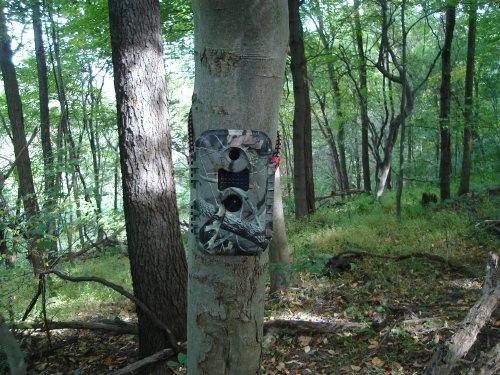|
Predator Evolution TrailcamThe Evolution uses a 0.04 LUX VGA color image sensor, which is supposed to be equivalent to a 4.0 megapixel camera. I’ll admit that I don’t really know the specifics of LUX versus megapixel digital cameras so I’ll just let the pictures speak for themselves. The Evolution also uses infrared for nighttime pictures. Picture quality is poor and we have given it a C. The daytime pictures are OK but you cannot blow them up due to their low resolution. The IR pictures are poor. You can read more about the picture quality and see some example pictures here. One option with this camera that could come in handy is that you set the time at which the camera uses IR. This allows you to get better daytime pictures when the IR mode is off. One drawback is these times will need to be changed as sunrise and sunset change, which could be a problem. The infrared light on this trail camera flashes like a white flash, although much dimmer, so I was able to test it just like I do those cameras. The Predator Evolution is the fastest trail camera I have tested through the 25 I have tested. The Predator Evolution Trailcam operates on 10 AA batteries and the manual recommends rechargeable batteries. 10 AA batteries are a lot of batteries but using rechargeable batteries helps take the sting out of this number. The first time I recharged batteries and put them in the camera they lasted about 18 days. If I can consistently get 18 days out of these batteries this isn't too bad. In these 18 days the camera too a few hundred pictures. One thing I like is that the camera tells you the voltage left in the batteries and the directions tell you the battery voltage at which the camera will no longer operate properly. I charged 10 batteries and they showed 13.0 volts and operated the camera until they showed 8.3 volts. The Evolution imprints the date and time on each picture. It is also supposed to imprint the temperature but I can’t find out how to make it do this. I had noticed that it was just putting the time and date on the pictures so when I checked the camera I looked for the temperature but could not figure out how to do it. Set-up is done using the touch screen. In general it is not real difficult but sometimes when you touch a button it will not respond and this can be frustrating since it tells you that you don’t have to push on the screen very hard. I also had a hard time figuring out how to put the camera in the active trailcam picture taking mode. There isn’t any place in the directions that tell you to push the RUN button. When you do press the RUN button the screen just goes black, so you really don’t know what you have done. Now that I know what to do it is easy, but it took a guess along with trail and error to get it right. A bracket is provided that can be screwed onto a tree and the Evolution can be attached to this bracket. There are also holes on the back of the Evolution through which a Python Locking cable can be used. The Predator Evolution Trailcam has no internal memory, a USB flash drive or a CF card may be used to save images. One important note is that according to the instructions it will not accept SanDisk USB flash drives. The Predator Evolution Trailcam has a 3.5 inch viewing screen. Images are produced four at a time and any one can be selected for viewing and also can be zoomed in on for a closer look. This is a nice size viewing screen and is relatively simple to use. One problem I had was that when there are no images it does not tell you that, which could leave you pressing the touch screen until you bruise your finger or ruin the screen. The time delays start at 30 seconds and can be changed in 30 second increments up to one hour. I like to see delays of less than 30 seconds but the Evolution does have the capability of taking up to five pictures each time it is activated, which helps make up for the 30 second delay. There is a walk test feature but you have to remember to turn it off and activate the camera. The Evolution also has video recording capabilities. I also need to mention that the case size and quality is the best of all of the major manufactured digital trail cameras. The case is compact and is similar in size and quality to the Penn’s Woods and our homemade WhitetailCam. I've given the Predator Evolution a C for an overall grade. This trail cam has some good qualities and some bad ones. The case is nice, the trigger speed is great and it is pretty easy on the AA rechargeable batteries. The downside is that you can't tell what many of the pictures are. During deer season I put this camera in a well traveled spot to monitor deer movement during the season. It took one picture one night where you could just tell that it was a buck, but I didn't have any idea exactly what this buck was. This is very frustrating, the camera works well enough to get the picture but many times you can't tell what is in the picture.


|
